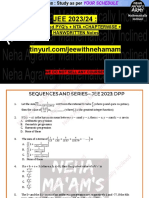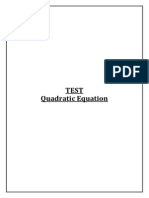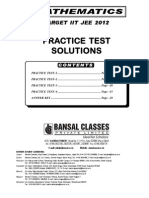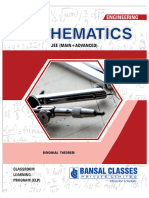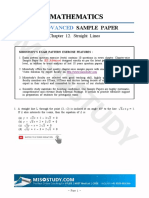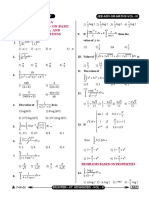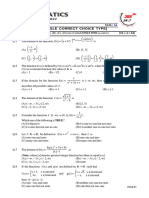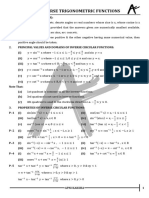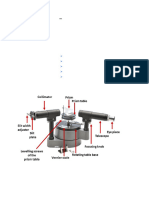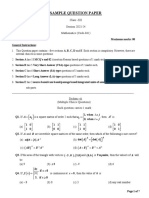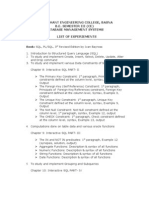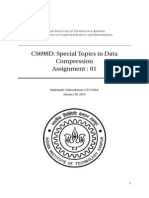Theory of Equations DPP-3
Theory of Equations DPP-3
Uploaded by
SaήjaγKsCopyright:
Available Formats
Theory of Equations DPP-3
Theory of Equations DPP-3
Uploaded by
SaήjaγKsCopyright
Available Formats
Share this document
Did you find this document useful?
Is this content inappropriate?
Copyright:
Available Formats
Theory of Equations DPP-3
Theory of Equations DPP-3
Uploaded by
SaήjaγKsCopyright:
Available Formats
Quadratic Equations (Condition for common roots, Position of roots, Maximum and Minimum Value ) DPP-3
1. If both the roots of k(6 x 2 + 3) + rx + 2x 2 − 1 = 0 and 6k(2x 2 + 1) + px + 4 x 2 − 2 = 0 are common, then 2r − p is
equal to
(A) –1 (B) 0 (C) 1 (D) 2
2. If a root of the equations x 2 + px + q = 0 and x 2 + x + = 0 is common, then its value will be (where p
and q )
q− p − q q− p − q
(A) (B) (C) or (D) None of these
−p q− −p q−
3. If the two equations x 2 − cx + d = 0 and x 2 − ax + b = 0 have one common root and the second has equal
roots, then 2(b + d) =
(A) 0 (B) a+c (C) ac (D) −ac
4. If x 2 − hx − 21 = 0, x 2 − 3hx + 35 = 0 (h 0) has a common root, then the value of h is equal to
(A) 1 (B) 2 (C) 3 (D) 4
5. If every pair of the equations x 2 + px + qr = 0 , x 2 + qx + rp = 0, x 2 + rx + pq = 0 have a common root, then the
sum of three common roots is
−(p + q + r ) −p + q + r
(A) (B) (C) −(p + q + r ) (D) −p + q + r
2 2
a3 + b3 + c 3
6. If ax 2 + bx + c = 0 and bx 2 + cx + a = 0 have a common root a 0 , then =
abc
(A) 1 (B) 2 (C) 3 (D) None of these
7. If the equation x 2 + px + q = 0 and x 2 + qx + p = 0 , have a common root, then p + q + 1 =
(A) 0 (B) 1 (C) 2 (D) –1
8. If x 2 + ax + 10 = 0 and x 2 + bx − 10 = 0 have a common root, then a2 − b 2 is equal to
(A) 10 (B) 20 (C) 30 (D) 40
9. x 2 − 11x + a and x 2 − 14 x + 2a will have a common factor, if a =
(A) 24 (B) 0, 24 (C) 3, 24 (D) 0, 3
10. If x 2 − 3 x + 2 be a factor of x 4 − px 2 + q, then (p, q) =
(A) (3, 4) (B) (4, 5) (C) (4, 3) (D) (5, 4)
11. If x be real, then the minimum value of x 2 − 8 x + 17 is
(A) –1 (B) 0 (C) 1 (D) 2
x 2 + 14x + 9
12. If x is real, then the maximum and minimum values of expression will be
x 2 + 2x + 3
(A) 4, – 5 (B) 5, – 4 (C) – 4, 5 (D) – 4, – 5
x+2
13. If x is real, the expression takes all value in the interval
2
2x + 3 x + 6
SRI CHAITANYA ACADEMY, INDIA
ADDRESS:- SCO 369-370, SECTOR-34-A, CHANDIGARH(UT)-160022
SCO-219, SECTOR 14 PANCHKULA PH-0172-4185137
Phone No: - 0172, 4185157, 4734111
1 1 1 1 1 1
(A) , (B) − 13 , 3 (C) − , (D) None of these
13 3 3 13
14. If x 2 + px + 1 is a factor of the expression ax 3 + bx + c , then
(A) a2 + c 2 = −ab (B) a2 − c 2 = −ab
(C) a2 − c 2 = ab (D) None of these
15. If x, y, z are real and distinct, then u = x 2 + 4 y 2 + 9z2 − 6 yz − 3zx − zxy is always
(A) Non-negative (B) Non-positive
(C) Zero (D) None of these
16. If x be real, then the maximum value of 5 + 4 x − 4 x 2 will be equal to
(A) 5 (B) 6 (C) 1 (D) 2
( x − a)(x − b)
17. If x is real, the function will assume all real values, provided
(x − c)
(A) abc (B) abc (C) acb (D) acb
x 2 − 3x + 4
18. If x is real, then the maximum and minimum values of the expression will be
x 2 + 3x + 4
1 1
(A) 2, 1 (B) 5, (C) 7, (D) None of these
5 7
x 2 + 34 x − 71
19. If x is real, then the value of does not lie between
x 2 + 2x − 7
(A) –9 and –5 (B) –5 and 9 (C) 0 and 9 (D) 5 and 9
20. If x is real, then the value of x 2 − 6 x + 13 will not be less than
(A) 4 (B) 6 (C) 7 (D) 8
21. The smallest value of x 2 − 3 x + 3 in the interval (−3, 3 / 2) is
(A) 3/4 (B) 5 (C) –15 (D) –20
22. If the roots of x 2 + x + a = 0 exceed a, then
(A) 2a3 (B) a3 (C) −3 a 3 (D) a −2
23. If the roots of the equation x 2 − 2ax + a2 + a − 3 = 0 are real and less than 3, then
(A) a2 (B) 2a3 (C) 3a4 (D) a4
24. If x be real, the least value of x 2 − 6 x + 10 is
(A) 1 (B) 2 (C) 3 (D) 10
25. Let , be the roots of x 2 + (3 − )x − = 0. The value of for which 2 + 2 is minimum, is
(A) 0 (B) 1 (C) 2 (D) 3
26. Let f ( x ) = x 2 + 4 x + 1 . Then
(A) f ( x ) 0 for all x (B) f ( x ) 1 when x 0
(C) f ( x ) 1 when x −4 (D) f ( x ) = f ( − x ) for all x
SRI CHAITANYA ACADEMY, INDIA
ADDRESS:- SCO 369-370, SECTOR-34-A, CHANDIGARH(UT)-160022
SCO-219, SECTOR 14 PANCHKULA PH-0172-4185137
Phone No: - 0172, 4185157, 4734111
27. The adjoining figure shows the graph of y = ax 2 + bx + c . Then
Y
O X
(x1,0) (x2,0)
(A) a0 (B) b 2 4ac (C) c0 (D) a and b are of opposite signs
28. If a, b, c are real numbers such that a + b + c = 0, then the quadratic equation 3ax 2 + 2bx + c = 0 has
(A) At least one root in [0, 1] (B) At least one root in [1, 2]
(C) At least one root in [−1, 0] (D) None of these
29. If , be the roots of the quadratic equation ax 2 + bx + c = 0 and k be a real number, then the condition so
that k is given by
(A) ac 0 (B) ak 2 + bk + c = 0
(C) ac 0 (D) a2k 2 + abk + ac 0
30. The value of p for which both the roots of the equation 4 x 2 − 20px + (25p2 + 15p − 66) = 0 are less than 2, lies
in
(A) ( 4 / 5, 2) (B) (2, ) (C) ( −1, − 4 / 5 ) (D) ( −, − 1)
31. If and (<) are the roots of the equation x 2 + bx + c = 0, where c 0 b, then
(A) 0 (B) 0 | | (C) 0 (D) 0 | |
32. If b a , then the equation ( x − a) ( x − b) = 1 has
(A) Both roots in [a, b] (B) Both roots in (−, a )
(C) Both roots in (b, + ) (D) One root in (−, a ) and the other in (b, + )
33. If and , and , and are the roots of the equations ax 2 + 2bx + c = 0 , 2bx 2 + cx + a = 0 and
cx 2 + ax + 2b = 0 respectively, where a, b and c are positive real numbers, then + 2 =
(A) –1 (B) 0 (C) abc (D) a + 2b + c
(E) abc
ANSWER KEY-DPP-3
Condition for common roots, Position of roots, Maximum and Minimum
Value
1 B 7 A 13 B 19 D 25 C 31 B
SRI CHAITANYA ACADEMY, INDIA
ADDRESS:- SCO 369-370, SECTOR-34-A, CHANDIGARH(UT)-160022
SCO-219, SECTOR 14 PANCHKULA PH-0172-4185137
Phone No: - 0172, 4185157, 4734111
2 C 8 D 14 C 20 A 26 C 32 D
3 C 9 B 15 A 21 A 27 A,D 33 B
4 D 10 D 16 B 22 D 28 A
5 A 11 C 17 D 23 A 29 D
6 C 12 A 18 C 24 A 30 D
SRI CHAITANYA ACADEMY, INDIA
ADDRESS:- SCO 369-370, SECTOR-34-A, CHANDIGARH(UT)-160022
SCO-219, SECTOR 14 PANCHKULA PH-0172-4185137
Phone No: - 0172, 4185157, 4734111
You might also like
- DFD For Software Personnel Management System: User AdminDocument8 pagesDFD For Software Personnel Management System: User AdminSix MusketeersNo ratings yet
- Single Choice Type (+2, 1) : STUDENT NAME: - Quadratic EquationsDocument1 pageSingle Choice Type (+2, 1) : STUDENT NAME: - Quadratic EquationsGitanshu AroraNo ratings yet
- Chapter Test-3 (Quadratic Equation)Document2 pagesChapter Test-3 (Quadratic Equation)Naman GoyalNo ratings yet
- Sequence & Series - Full Assignment - 25195873Document6 pagesSequence & Series - Full Assignment - 25195873sunitakuri1205No ratings yet
- Worksheet LimitsDocument4 pagesWorksheet LimitsBiswajeet ChakrabortyNo ratings yet
- (Eduwaves360) Indef Def 12th (2019c) eDocument76 pages(Eduwaves360) Indef Def 12th (2019c) eAlbertNo ratings yet
- HOMEWORK Algebra 3 Feb 212023Document6 pagesHOMEWORK Algebra 3 Feb 212023Sharmaine FajutaganaNo ratings yet
- DPP2 Inequality1Document1 pageDPP2 Inequality1sandeep singhNo ratings yet
- Assignment On Greatest Integer Function For Class Xi (2021 - 2022)Document2 pagesAssignment On Greatest Integer Function For Class Xi (2021 - 2022)ffffffgNo ratings yet
- Progression QuizDocument2 pagesProgression QuizGulshan kumarNo ratings yet
- Straight Line (Question Paper)Document4 pagesStraight Line (Question Paper)Vikas MeenaNo ratings yet
- Chapwise Questions Maths IitDocument50 pagesChapwise Questions Maths IitsanchitNo ratings yet
- DPP TrigonometryQBDocument6 pagesDPP TrigonometryQBKrishna BhalekarNo ratings yet
- STP - 7 (Function) Que.Document2 pagesSTP - 7 (Function) Que.Sarvesh DubeyNo ratings yet
- Q - 1998 To 2022 MergeDocument215 pagesQ - 1998 To 2022 MergeRahul SharmaNo ratings yet
- Basic Math QuestionDocument20 pagesBasic Math QuestionChampions EventuallyNo ratings yet
- Limits Continuity and Differentia-Jeemain - GuruDocument17 pagesLimits Continuity and Differentia-Jeemain - Gururohan rajNo ratings yet
- Sequence & Series DPPDocument3 pagesSequence & Series DPPSarthak LambaNo ratings yet
- Sartaj CL Asses: Test SeriesDocument8 pagesSartaj CL Asses: Test SeriesM. Shoeb SultanNo ratings yet
- Test Quadratic EquationDocument4 pagesTest Quadratic EquationJibran SiddiquiNo ratings yet
- QE - 11th (2019C) - EDocument36 pagesQE - 11th (2019C) - EAlbertNo ratings yet
- JEE Math Problems SetDocument11 pagesJEE Math Problems SetshriteshNo ratings yet
- Problem Practice For Class XIIDocument42 pagesProblem Practice For Class XIISunil SinghNo ratings yet
- Theory of Equation Problems OnlyDocument7 pagesTheory of Equation Problems OnlyVirat KkohliNo ratings yet
- RT Solutions-Practice Test Papers XIII VXY 1 To 6 SolDocument40 pagesRT Solutions-Practice Test Papers XIII VXY 1 To 6 Solvishal110085No ratings yet
- JEE Main Sequences and Series Important QuestionsDocument17 pagesJEE Main Sequences and Series Important Questionsshreenath gajalwarNo ratings yet
- DPP Adv. DAY 1 15042019.pdf-42 PDFDocument25 pagesDPP Adv. DAY 1 15042019.pdf-42 PDFAbhinav RajeshNo ratings yet
- Mathematics v2 PDFDocument17 pagesMathematics v2 PDFMonil PitliyaNo ratings yet
- Circles SheetDocument15 pagesCircles Sheetkishangopi123No ratings yet
- M-10-T1-03 Quadratic Equation PDFDocument45 pagesM-10-T1-03 Quadratic Equation PDFAniketNo ratings yet
- JEE Main 2019 PYQDocument189 pagesJEE Main 2019 PYQAnant JainNo ratings yet
- BIN - 11th (2019C) - EmbhbjkhjDocument28 pagesBIN - 11th (2019C) - Embhbjkhjroving9fantasyNo ratings yet
- Straight Lines Question Paper For JEE Advanced 2019Document6 pagesStraight Lines Question Paper For JEE Advanced 2019misostudyNo ratings yet
- Vectors Jeemain - GuruDocument9 pagesVectors Jeemain - Gururohan raj100% (1)
- DNM SolnDocument27 pagesDNM SolnManavSaksariaNo ratings yet
- PYQ Class 11Document122 pagesPYQ Class 11Prashant GargNo ratings yet
- DPP - III Linear Equations: y X y X y X y XDocument3 pagesDPP - III Linear Equations: y X y X y X y XGeeth SagarNo ratings yet
- Complex Number Assignment PDFDocument33 pagesComplex Number Assignment PDFSurya YadavNo ratings yet
- Advance DPP-1 (Mathmatics) )Document3 pagesAdvance DPP-1 (Mathmatics) )Ashish GiriNo ratings yet
- M Ch-06 MatricesDocument7 pagesM Ch-06 Matricesmysoftinfo.incNo ratings yet
- Class 11th D.P.PDocument4 pagesClass 11th D.P.PMukesh KumarNo ratings yet
- 2b.definite Integration (102-114) FinalDocument13 pages2b.definite Integration (102-114) FinalSurya teja cvNo ratings yet
- Vector and 3-d by Mohit Tyagi SitDocument24 pagesVector and 3-d by Mohit Tyagi SitRahul SinghNo ratings yet
- Bansal MoleDocument60 pagesBansal Moletushar.gautam.cer12100% (1)
- Practice Test FunctionsDocument3 pagesPractice Test FunctionsRahul JainNo ratings yet
- Part-A: CLASS: CC (Advanced) TEST-21 M.M.: 69 Time: 60 MinDocument4 pagesPart-A: CLASS: CC (Advanced) TEST-21 M.M.: 69 Time: 60 MinQgqhahsjNo ratings yet
- Sequence & Series 3Document1 pageSequence & Series 3bajpaiinesh1No ratings yet
- Fundamental Day 1 Home WorkDocument2 pagesFundamental Day 1 Home WorkAnish PagareNo ratings yet
- Permutation & Combination Sheet by Om SirDocument12 pagesPermutation & Combination Sheet by Om SirNix FatalNo ratings yet
- 00000773-02 # ASSINGEMENT - N - TNPS - Quadratic EquationDocument14 pages00000773-02 # ASSINGEMENT - N - TNPS - Quadratic EquationAshish GiriNo ratings yet
- 13.inequalities Question BankDocument4 pages13.inequalities Question BankkeerthanasubramaniNo ratings yet
- FunctionDocument17 pagesFunctionsuar90No ratings yet
- Allen 27 January Shift 1Document29 pagesAllen 27 January Shift 1UNKNOWN LEGENDNo ratings yet
- Target: Jee-2021Document2 pagesTarget: Jee-2021anubhav pandeyNo ratings yet
- Inverse Trigonometric Functions: General Definition (S)Document20 pagesInverse Trigonometric Functions: General Definition (S)educationyt2005No ratings yet
- Rel & Fun - 12th (2019C) - E ModifiedDocument52 pagesRel & Fun - 12th (2019C) - E ModifiedAnubhav KushagraNo ratings yet
- WS-1 (Qee)Document4 pagesWS-1 (Qee)Anoushka nathNo ratings yet
- DPP-3 Quadratic Equation - OmgDocument6 pagesDPP-3 Quadratic Equation - OmgSumit RajNo ratings yet
- Quadratic Home AssignmentDocument4 pagesQuadratic Home AssignmentSunilSutharNo ratings yet
- Quadratic Equations: Objective ProblemsDocument29 pagesQuadratic Equations: Objective ProblemsJayasurya PaluriNo ratings yet
- Race-16 - Quadratic EquationDocument2 pagesRace-16 - Quadratic EquationCrazy JaatNo ratings yet
- FALLSEM2024-25 BPHY101P LO VL2024250107900 2024-09-20 Reference-Material-IDocument26 pagesFALLSEM2024-25 BPHY101P LO VL2024250107900 2024-09-20 Reference-Material-ISaήjaγKsNo ratings yet
- Parts of SpeechDocument22 pagesParts of SpeechSaήjaγKsNo ratings yet
- KINAMETICSDocument6 pagesKINAMETICSSaήjaγKsNo ratings yet
- 11th DPP 1D Kinematic-1Document5 pages11th DPP 1D Kinematic-1SaήjaγKsNo ratings yet
- 24BVD0072 VL2024250106550 Ast02Document4 pages24BVD0072 VL2024250106550 Ast02SaήjaγKsNo ratings yet
- 2-2-1 (English L & L)Document8 pages2-2-1 (English L & L)SaήjaγKsNo ratings yet
- AssignmentDocument2 pagesAssignmentSaήjaγKsNo ratings yet
- FALLSEM2024-25 BSTS201P SS VL2024250102674 2024-09-20 Reference-Material-IDocument18 pagesFALLSEM2024-25 BSTS201P SS VL2024250102674 2024-09-20 Reference-Material-ISaήjaγKsNo ratings yet
- DPPDocument5 pagesDPPSaήjaγKsNo ratings yet
- Inequalities 1Document2 pagesInequalities 1SaήjaγKsNo ratings yet
- Inequalities PDFDocument3 pagesInequalities PDFSaήjaγKsNo ratings yet
- DPP 7 PDFDocument5 pagesDPP 7 PDFSaήjaγKsNo ratings yet
- DPP Physics VECTOR DPP 2Document2 pagesDPP Physics VECTOR DPP 2SaήjaγKsNo ratings yet
- Sector 37-B, Chandigarh, PH.: 0172-2698800 E-Ma Il: Lnfo@stpete RCHD .Co M Schoo L Code:23033Document1 pageSector 37-B, Chandigarh, PH.: 0172-2698800 E-Ma Il: Lnfo@stpete RCHD .Co M Schoo L Code:23033SaήjaγKsNo ratings yet
- Vectors DPP-3 PDFDocument7 pagesVectors DPP-3 PDFSaήjaγKsNo ratings yet
- FemaleinfanticideDocument7 pagesFemaleinfanticideSaήjaγKsNo ratings yet
- Indian Institute of Science20220211Document20 pagesIndian Institute of Science20220211SaήjaγKsNo ratings yet
- Answers & Solutions JEE (Main) - 2023 (Online) Phase-2: Memory BasedDocument16 pagesAnswers & Solutions JEE (Main) - 2023 (Online) Phase-2: Memory BasedSaήjaγKsNo ratings yet
- Answers & Solutions JEE (Main) - 2023 (Online) Phase-2: Memory BasedDocument15 pagesAnswers & Solutions JEE (Main) - 2023 (Online) Phase-2: Memory BasedSaήjaγKsNo ratings yet
- Answers & Solutions JEE (Main) - 2023 (Online) Phase-2: Memory BasedDocument13 pagesAnswers & Solutions JEE (Main) - 2023 (Online) Phase-2: Memory BasedSaήjaγKsNo ratings yet
- Class XI FINAL RESULT 2022-2023Document1 pageClass XI FINAL RESULT 2022-2023SaήjaγKsNo ratings yet
- IB V.2.0 JEE Adv 2023 EnglishDocument115 pagesIB V.2.0 JEE Adv 2023 EnglishSaήjaγKsNo ratings yet
- Jee Mains Previous Year Paper Physics 2022 - 29 JUN - Shift 1 (Actual)Document34 pagesJee Mains Previous Year Paper Physics 2022 - 29 JUN - Shift 1 (Actual)SaήjaγKsNo ratings yet
- Answers & Solutions JEE (Main) - 2023 (Online) Phase-2: Memory BasedDocument15 pagesAnswers & Solutions JEE (Main) - 2023 (Online) Phase-2: Memory BasedSaήjaγKsNo ratings yet
- Class XI FINAL RESULT 2022-2023Document1 pageClass XI FINAL RESULT 2022-2023SaήjaγKsNo ratings yet
- Answers & Solutions JEE (Main) - 2023 (Online) Phase-2: Memory BasedDocument16 pagesAnswers & Solutions JEE (Main) - 2023 (Online) Phase-2: Memory BasedSaήjaγKsNo ratings yet
- UntitledDocument1 pageUntitledSaήjaγKsNo ratings yet
- Central Board of Secondary Education, Delhi: Sample Question Paper Class-Xii (2023-2024) Physical EducationDocument8 pagesCentral Board of Secondary Education, Delhi: Sample Question Paper Class-Xii (2023-2024) Physical EducationSaήjaγKsNo ratings yet
- Central Board of Secondary EducationDocument2 pagesCentral Board of Secondary EducationSaήjaγKsNo ratings yet
- Maths SQPDocument8 pagesMaths SQPSaήjaγKsNo ratings yet
- Homework One Step EquationsDocument8 pagesHomework One Step Equationsg1buk0h0fek2100% (1)
- What Does DW Stand For: Dear Wife"Document1 pageWhat Does DW Stand For: Dear Wife"howyNo ratings yet
- 2sk3679 - 900V, 9ADocument4 pages2sk3679 - 900V, 9ARenatoMaiaNo ratings yet
- DBMS Analysis and Comparison: A Micro Project OnDocument12 pagesDBMS Analysis and Comparison: A Micro Project OnDhiraj Chaudhari CO-137No ratings yet
- EWS Certificate No.: - EWS Certificate DateDocument2 pagesEWS Certificate No.: - EWS Certificate DateKamaliya AshwinNo ratings yet
- Google PhoneDocument22 pagesGoogle PhoneMarikani MurugesanNo ratings yet
- Cognizant Technology SolutionsDocument4 pagesCognizant Technology SolutionsT Prashanth KumarNo ratings yet
- EziDebit - DDR Form - CompletePTDocument2 pagesEziDebit - DDR Form - CompletePTAndrewNeilYoungNo ratings yet
- W D 9 3 0 2 4Document7 pagesW D 9 3 0 2 4SemnalmecNo ratings yet
- DLL - MTB MLE3 - Q4 - W2 Paggawa NG Banghay NG Ulat EdumaymaylauramosangieDocument6 pagesDLL - MTB MLE3 - Q4 - W2 Paggawa NG Banghay NG Ulat EdumaymaylauramosangieROSVIE APPLE BUENAVENTURANo ratings yet
- Salaoon Booking Application - SowDocument2 pagesSalaoon Booking Application - Sowvibrant procurementNo ratings yet
- DBMS Practical ListDocument3 pagesDBMS Practical ListHardik JaniNo ratings yet
- Data Compression SolutionDocument11 pagesData Compression SolutionMuktinath VishwakarmaNo ratings yet
- Joystick GMKDocument8 pagesJoystick GMKmazizNo ratings yet
- Instructional Media and Technologies For LearningDocument24 pagesInstructional Media and Technologies For LearningNORITA AHMADNo ratings yet
- Numerical Inversion of Laplace Transforms in MatlabDocument4 pagesNumerical Inversion of Laplace Transforms in MatlabErza ScarletNo ratings yet
- IP SAN BestPractice WP PDFDocument11 pagesIP SAN BestPractice WP PDFFrancine HerdingNo ratings yet
- Class Diagram and RelationshipDocument45 pagesClass Diagram and RelationshipRohit AgrawalNo ratings yet
- M2 +Fundamental+of+Computer-Aided+Mathematical+CalculationsDocument4 pagesM2 +Fundamental+of+Computer-Aided+Mathematical+CalculationsKpop Harteu100% (1)
- Lis Education in E-Learning Environment: Problems and Proposal For BangladeshDocument11 pagesLis Education in E-Learning Environment: Problems and Proposal For BangladeshadnanNo ratings yet
- Police - Application Status SearchDocument3 pagesPolice - Application Status SearchM NARASIMHANo ratings yet
- Chapter 4 PSLDocument8 pagesChapter 4 PSLMark NeishaburiNo ratings yet
- Interfacing Memory Chips With 8085Document10 pagesInterfacing Memory Chips With 8085Honsyben BriansNo ratings yet
- MultitaskingDocument6 pagesMultitaskingMuhammad AhmedNo ratings yet
- Eyezone B1080P-3 Manual (9.0.7)Document23 pagesEyezone B1080P-3 Manual (9.0.7)malina888No ratings yet
- Applying Ocs Patches: Type Area Topic AuthorDocument16 pagesApplying Ocs Patches: Type Area Topic AuthorPILLINAGARAJUNo ratings yet
- Electrical and Computer Engineering: Curriculum & ProgramsDocument6 pagesElectrical and Computer Engineering: Curriculum & ProgramsEric XiaoNo ratings yet
- Exp 01Document5 pagesExp 01Emdadul Haque EmonNo ratings yet
- PGP 1 Case StudyDocument3 pagesPGP 1 Case StudyarindamNo ratings yet

















